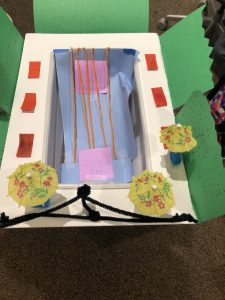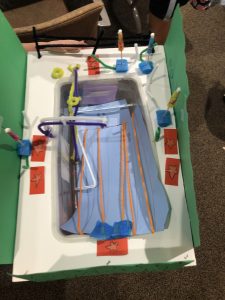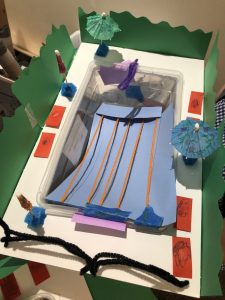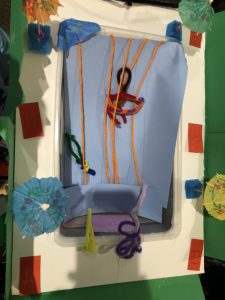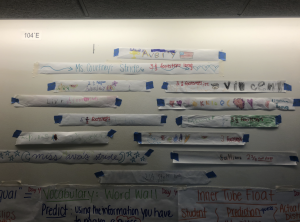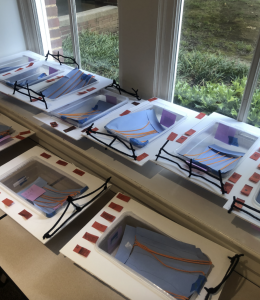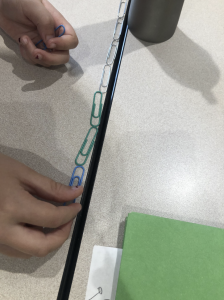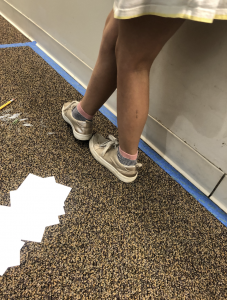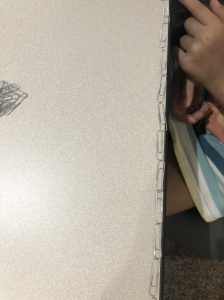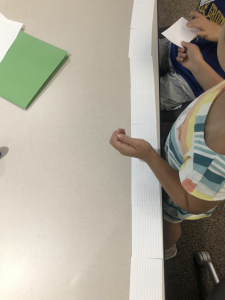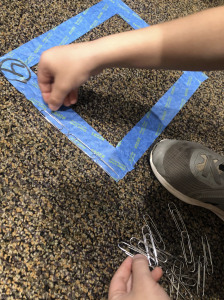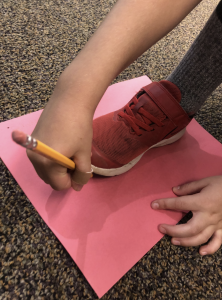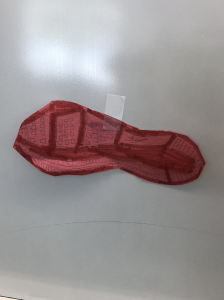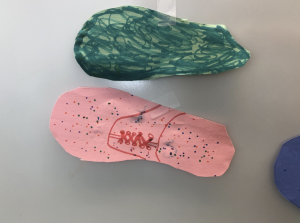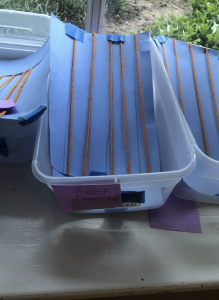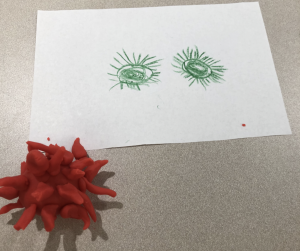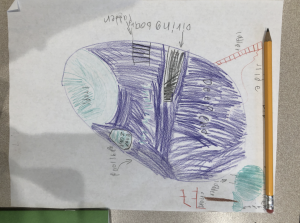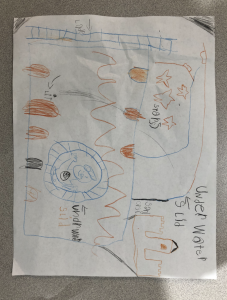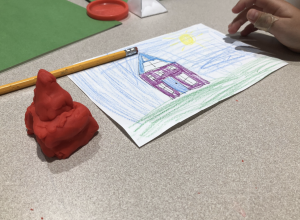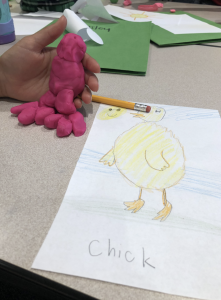Summer SAVY 2022/Session 4 – Dive into Design for Rising 1st/2nd Grade
Friday: Happy Friday!
Pool-a-palooza went off with a bang! We dove deep into learning about how accurate measurements require identical units, precise starting and ending points, no gaps, or overlaps in coverage, and partitioning of left-over (non-whole) units (measurement accuracy), and using what you know about an object may be helpful in making an educated guess about the numerical approximation of an object (estimation). Your student came home with their final projects today. Check out their 3D pool models and compare it to their 2D blueprint. Every part of the 3D model was measured in standard units – ask your child if they used inches or centimeters and why! Which item was the longest? Which had the greater perimeter? How would you compare the depth of the deep end to the depth of the shallow end? If you could add any other features, what would they be? How would their size in the 3D model compare to the size of the other pool components (scaling)?
Thank you so much for a wonder and inquisitive week of exploring! Get some rest and cool down in the pool this weekend! We hope to see you at another SAVY session soon!
Check out the picture of some 3D pools. What features do you see?
Warmly,
Ms. Courtney and Ms. Ava
Thursday: Happy Thursday!
Our pool designs are almost complete! We’ve added to and edited our 2D pool blueprints throughout the week and have been bringing our ideas to life! Ask your learner about what they added to their pool decks today! (fence and beach towels). We finished up learning about non-standard units of measure and dove into standard units of measurement. We read Millions to Measure by David Schwartz and explored that we can measure more than length. We also discussed equivalence among units of measurement and which tools are easier to use depending on the size of the object to be measured. We explored how the length of our legs and feet impact the length of our strides.
To measure, we learned that accurate measurements require identical units, precise starting and ending points, no gaps, or overlaps in coverage, and partitioning of left-over (non-whole) units (measurement accuracy). We practiced using what you know about an object may be helpful in making an educated guess about the numerical approximation of an object (estimation).
We discovered that the larger the unit, the smaller the number of units needed to measure a particular object; the smaller the unit, the larger the number of units needed to measure a particular object (inverse relationship between size of units and number of units), certain units convey what is being measure better than others (appropriate units), and certain tools work better than others to measure the same attributes (appropriate tools).
Check out the photos of our “Stride Strips” and see how our 3D pool models are coming along!Some dinner table questions:
About how long is the length of __________? Width of _______? How do you know? What units did you use?
If I wanted to measure ________, would it be better to use a foot long ruler or meter stick? Why do you think that?
You can measure length, width, and height of objects. Consider other things that you can measure. How do you measure time? Weight? Speed? Distance?
Is it better to use standard or non-standard units of measurement? Why do you think that?
See you tomorrow!
Warmly,
Ms. Courtney and Ms. Ava
Wednesday: Happy Wednesday! What a wonderful Wednesday it was… We explored how to measure paths that twist and turn and not let our eyes deceive us! Just because a path looks longer or shorter doesn’t mean that it is when it comes to measurement! Ask your learner about comparing the crazy swimmers’ path and how they determined which swimmer swam further, and ask about how they created a model to represent the path a ball travels. Models of pools were set up all over the room and we measured the length and width of each pool using non-standard units like index cards, paperclips, and our own feet! We discovered that measuring with non-standard units requires great care and careful consideration. Not all feet are the same length, position matters, and you shouldn’t overlap or leave space between your measuring units!
We further explored that the length of an object can be divided into equal-sized units (partitioning) and the length of a larger unit may be made up of repeating smaller units (iteration). Also, sets of items may look different, but represent the same amount of equivalence, and sometimes a close approximation of a number is accurate enough (rounding).
Check out the photos from some of our hands-on activities today!
Some dinner table ideas:
-
How can you measure the length of your dinner table using non-standard units? How many spoons is the length of the table? How many spoons is the width of the table? How can you use that information to determine the total number of spoons it would be to measure the perimeter of the table? How can you measure the length or width of the table only using two spoons?
See you tomorrow!
Warmly,
Ms. Courtney and Ms. Ava
Tuesday: Happy Tuesday! Parents, thank you so much for allowing your student to bring models from home today! We enjoyed sharing them and reviewing concepts from Day 1 with them.
Today was full of hands-on activities as we explored how items remain the same length even when placed in a different position (conservation) and the concept of transitivity- knowing the relationship between one item and a second item, and between the second item and a third item, one may deduce the relationship between the first item and the third item. We created models on strips of paper to solve riddles of comparison and compared 2D models of our footprints based on length and width.
We used pipe cleaners, Unifix cubes, and playdough to explore how the length of an object can be divided into equal-sized units (partitioning) and sets of items may look different, but represent the same amount of equivalence.
Our pool models are coming to life step by step! Ask your learner about how we took today’s learning and applied it to the newest addition to our pool designs and how they figured out how to partition 6 equal lanes to their 3D pool models.
Some dinner table questions:
-How would you compare the height of ____ to _____?
– Is the ______ shorter/longer than ______? How do you know?
– Imagine you would break _____ into ______ equal parts? What would the size of each piece look like?
Check out the pictures of our 2D shoe models, how we compared ribbon lengths without seeing all three ribbons at once, and how our 3D pool models are coming along!
See you Wednesday!
Warmly,
Ms. Courtney and Ms. Ava
Monday: Happy Monday and welcome to Dive into Design! Our class is off to a great start. We had a wonderful day getting to know each other and diving into the world of measurement and design. Today, we discovered our challenge for the week:
“A swimming pool is about to be built in your neighborhood! The architect and construction workers need your help to figure out how to build it. The community has had several meetings to decide how to design the pool, but everyone seems to have different ideas about how deep the pool should be, what shape it should have, and what special features would be important. The adults cannot seem to agree on a design, so now the architect has decided to ask you for your ideas!”
We started our design process as architects by drawing a model to plan our pool. We learned:
-
(lesson 1) Objects with different attributes are measured in different ways. 2D shapes can be measured in two ways (length and width) and 3D shapes can be measured in three ways (length, width, and height).
-
(lesson 2) a model is a physical, conceptual, or mathematical simplification of an object or process
-
(lesson 3) items may be grouped by comparing and contrasting their attributes
Ask your child about models and challenge them to select an item from home that is a model and bring it to class on Tuesday. (Please ensure that this model is not breakable). Look for ideas such as: Models are smaller versions of the real thing. Models are a sample version of something. Models represent something real. Examples include stuffed animals, toy cars, photographs of people, illustrations, etc.
Check out these photos to see some initial pool blueprints and see how we turned 2D models into 3D models!
See you tomorrow!
-Ms. Courtney and Ms. Ava

